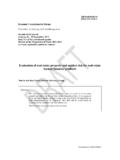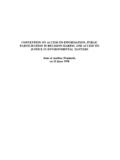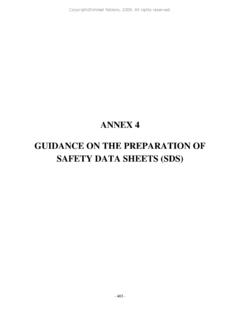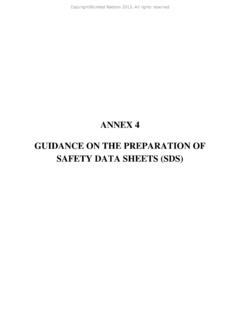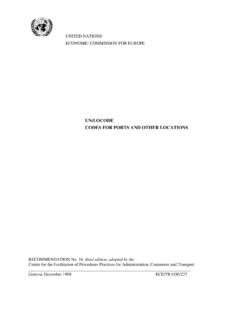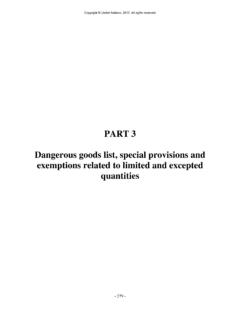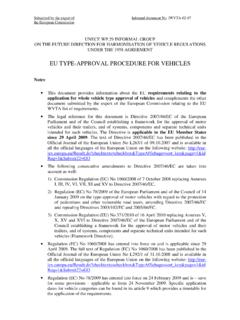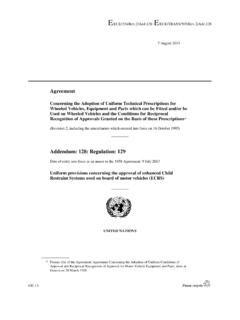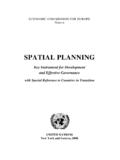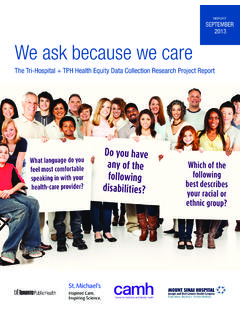Transcription of UNITED NATIONS ECONOMIC COMMISSION FOR EUROPE
1 UNITED NATIONS ECONOMIC COMMISSION FOR EUROPE CONFERENCE OF EUROPEAN STATISTICIANS Managing Statistical confidentiality & Microdata Access PRINCIPLES AND GUIDELINES OF GOOD PRACTICE UNITED NATIONS New York and Geneva, 2007 Note The designations employed and the presentation of the material in this publication do not imply the expression of any opinion whatsoever on the part of the Secretariat of the UNITED NATIONS , concerning the legal status of any country, territory, city or area, or of its authorities, or concerning the delimitation of its frontiers or boundaries. UNITED NATIONS PUBLICATION Sales No. ISBN 13: 987-92-1-116959-1 ISSN: 0069-8458 Copyright UNITED NATIONS , 2007 All rights reserved ii ii Explanatory Note These Guidelines have been prepared at the request of the Conference of European Statisticians (CES) by a Task Force chaired by Dennis Trewin (the Australian Statistician).
2 The guidelines and Core Principles of confidentiality and Microdata Access were adopted by the CES plenary session on June 2006 and the CES Bureau in October 2006. The Guidelines will be a dynamic document in that it will be updated from time to time. In particular, it is anticipated that additional Case Studies will be incorporated. The electronic version of the guidelines is available at the UNECE Statistical Division s website: are always welcome. Comments can be sent to Acknowledgements This work is the result of the efforts of a Task Force set up by the Conference of European Statisticians (CES). The Task Force members were: Ivan Fellegi (Canada), Otto Andersen (Denmark), Teimuraz Beridze (Georgia), Luigi Biggeri (Italy) and Tadeusz Toczynski (Poland). Dennis Trewin (Australia), the Chairman of the Task Force, has made a significant contribution to the work by drafting the text and incorporating the inputs from countries and international organizations throughout the several consultation stages of the document.
3 Tiina Luige and Gauri Khanna of the Statistical Division of the UNECE were of great assistance to the Task Force. Svante berg (Sweden) and Heinrich Br ngger (UNECE) have also provided considerable assistance to the Task Force during the course of their work. Several countries have provided case studies to support the Guidelines and their efforts are greatly appreciated. This publication also draws from presentations given at the CES seminar on statistical confidentiality and access to microdata (June 2003), see: iii Finally, the Bureau of the CES has provided constructive guidance throughout this project. iii iv CONTENTS I. Introduction_____1 II. Why should national statistical offices support the research community?__3 III. Core principles_____6 IV.
4 Supporting legislation_____8 V. Methods of supporting the research community_____9 VI. Managing tensions between national statistical offices and researchers__16 VII. Management issues associated with the release of microdata_____20 VIII. Some special issues_____22 Annex 1. Case studies_____25 Annex legislation to support release of microdata - Australia_____26 Annex legislation to support release of microdata - Finland_____29 Annex Data cubes - Netherlands_____32 Annex Public use microdata - UNITED States_____34 Annex Release of anonymised microdata files (licensed files) - Australia_____37 Annex Release of licensed microdata files - Netherlands_____40 Annex Release of licensed microdata files - Sweden_____44 Annex Remote data access facilities - Canada_____47 Annex Remote access facility (for microdata access) - Australia_____50 Annex Remote access to microdata files - Denmark_____52 Annex Research data centre program - Canada_____56 Annex Research data centres UNITED States_____59 Annex Data laboratory arrangements - Netherlands_____63 Annex Data laboratory microdata access - New Zealand_____67 Annex Data laboratory microdata access - Brazil_____70 Annex Microdata laboratory analysis - Italy_____75 Annex Managing decision making on confidentiality - Slovenia_____78 Annex Managing decision making on confidentiality - Australia_____83 Annex Microdata access in the OECD programmes for international student assessment (PISA)
5 _____85 Annex Policy on international release of microdata - Australia_____88 Annex Management of record linkage projects - Canada_____91 Annex Data linking when preparing microdata for research - Sweden_____95 Annex Access to anonymized census microdata samples via the IPUMS-International and the Integrated European Census Microdata Websites - University of Minnesota Population Center_____ 98 Annex 2. Standard terminology used in the guidelines_____ 106 v vi MANAGING STATISTICAL confidentiality AND MICRODATA ACCESS 1 I. INTRODUCTION 1. Historically, confidentiality protection has been mainly a national issue. However, in the context of increasing data dissemination over the Internet, it is now also becoming an international issue. There is a great deal of international collaboration among members of the research community, and the researchers can be very critical towards different access rules in different countries.
6 Furthermore, researchers are often not allowed to access other countries microdata for fear that confidentiality protection cannot be guaranteed. Nevertheless, cross-country comparisons can be a very important part of a research project. This is not only of interest to academic researchers. International agencies are among those who want to use microdata for research purposes, particularly cross-country comparisons. Such studies are usually of great interest and relevance to the participating countries. 2. This raises the question of whether it is possible to internationally agree on some common principles for dissemination of microdata. This question should be seen in the context of the 2003 Conference of European Statisticians (CES) agreeing that support for research is an important activity of the National Statistical Offices (NSOs), and generally NSOs could do more to satisfy these needs.
7 Doing more includes providing access to microdata which is the main focus of these principles and guidelines. (Although the reference is to NSOs in these guidelines, in many countries, particularly those with decentralised systems, there are several statistical producers. The reference to NSOs should be read as incorporating all producers of official statistics.) 3. There are two key objectives in these guidelines: (i) to foster greater uniformity of approach by countries whilst facilitating better access to microdata by the research community for worthwhile purposes; and (ii) through these guidelines and supporting case studies, to enable countries to improve their arrangements for providing access to microdata. 4. The term microdata is used throughout the paper. It can refer to data about an individual person, household, business or other entity. It may be data directly collected by the NSO or obtained from other sources, such as administrative sources.
8 5. These guidelines recognise that the precise arrangements for access to microdata will vary from country to country. They will depend on matters such as legislation , public attitudes and the capacity to support the research community. For example, the arrangements for a well-developed statistical office will be quite different from those in a less well-developed statistical office. Some countries may also feel they do not have either the systems or resources to maintain the necessary confidentiality safeguards. It should not be anticipated that each country will come up with precisely the same arrangements, although it is hoped these guidelines will lead to greater uniformity of approach. 6. We should also be mindful that not all countries are coming from the same position. Some countries, particularly from Eastern EUROPE , have traditionally not had strong legislation supporting confidentiality .
9 This is being changed in many cases but the cultural change to support the legislative change can take longer. MANAGING STATISTICAL confidentiality AND MICRODATA ACCESS 2 7. A number of countries have existing legislation . Also the European Union (EU) has legislation on confidentiality that embodies several principles and rules. These will already be applied by many ECE countries, especially the EU countries. It is recognised that existing legislation is not easily changed and that changes to existing guidelines require collaboration with a range of stakeholders. But opportunities do arise from time to time and these guidelines and the associated case studies may be useful in determining appropriate changes. Indeed, in some countries, these guidelines may provide a useful stimulus for debating and agreeing on changes. 8. Any questions on these guidelines should be submitted by e-mail to the Statistics Division of the UNECE at MANAGING STATISTICAL confidentiality AND MICRODATA ACCESS II.
10 WHY SHOULD NATIONAL STATISTICAL OFFICES SUPPORT THE RESEARCH COMMUNITY? 9. In most countries, official statistics are collected not just for governments but for the use of the community. This is particularly the case in democracies where official statistics can be used to assess the effectiveness of governments policies and programmes they provide a mirror on society. 10. To quote a 1993 White Paper on Open Government in the UNITED Kingdom: Official statistics are collected by government to inform debate, decision making and research both within government and by the wider community. They provide an objective perspective of the changes taking place in national life and allow comparisons between periods of time and geographical areas. Open access to official statistics provides the citizen with more than a picture of society. It offers a window on the work and performance of government itself, showing the scale of government activity in every area of public policy and allowing the impact of public policies and actions to be assessed.
